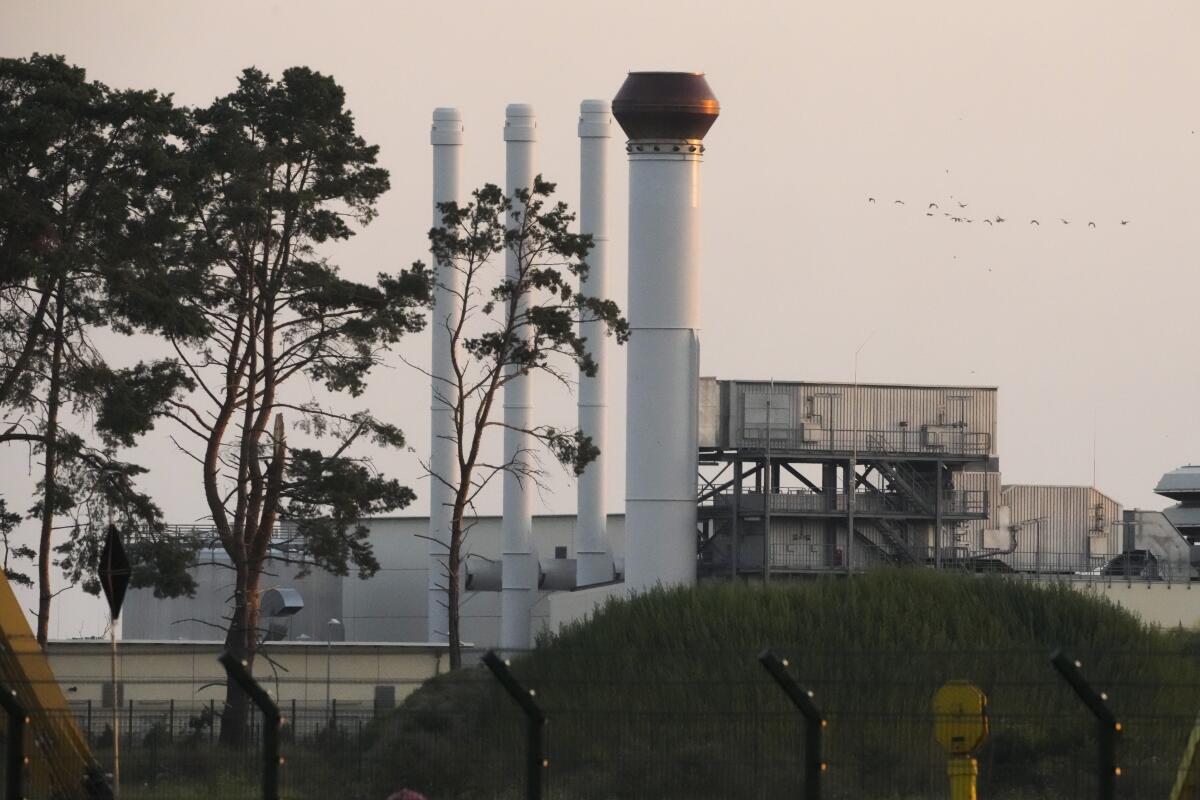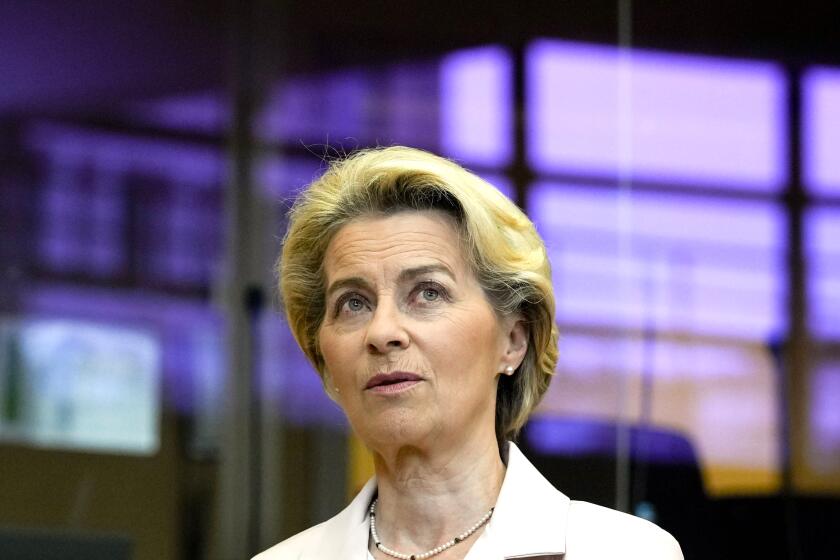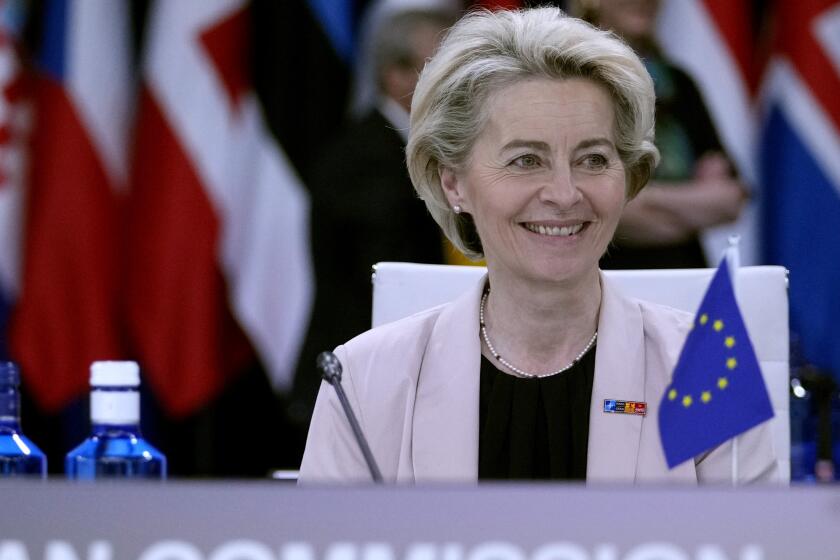Gas starts flowing from Russia to Europe again after break, but shutoff fears remain

- Share via
BERLIN — Natural gas started flowing through a major pipeline from Russia to Europe on Thursday after a 10-day shutdown for maintenance — but the gas flow remained well short of full capacity and the outlook was uncertain, leaving Europe still facing the prospect of a hard winter.
Deliveries through the Nord Stream 1 pipeline under the Baltic Sea resumed at 40% of capacity, the level they had been at for weeks before the annual maintenance work. The German government announced that it would step up its gas storage requirements and take further measures to save gas.
The pipeline had been closed since July 11. Amid growing tensions over Russia’s war in Ukraine, German officials had feared that the pipeline — the country’s main source of Russian gas, which recently has accounted for around a third of Germany’s gas supplies — might not reopen at all.
But the gas deliveries that were arriving still weren’t enough to resolve Europe’s energy crisis, and officials suspect that Russia is likely to disrupt supplies further. German Vice Chancellor Robert Habeck said the reduced supply “speaks a clear political language and confirms that we can’t rely on deliveries.”
“The outlook is simply extremely volatile,” said Klaus Mueller, the head of Germany’s network regulator. “We must save more to get through the next two winters well.”
Russia’s state-owned Gazprom reduced the flow through Nord Stream 1 by 60% in mid-June, citing technical problems involving equipment that partner Siemens Energy sent to Canada for overhaul and that couldn’t be returned because of sanctions imposed over Russia’s invasion of Ukraine.
While the 15% cuts in gas use would be voluntary, the European Commission asked for the power to impose mandatory reductions if necessary.
The Canadian government earlier this month gave permission for the turbine that powers a compressor station at the Russian end of the pipeline to be delivered to Germany.
The German government has rejected Gazprom’s technical explanation for the gas reduction, repeatedly calling it a pretext for a political decision by the Kremlin to sow uncertainty and further push up energy prices. It has said that the turbine was a replacement that wasn’t to be installed until September.
“Russia is using the great power it has — too great a power, which we gave Russia — to blackmail Europe,” said Habeck, who is also Germany’s economy minister and is responsible for energy. He said of the turbine: “Sometimes one has the impression that Russia doesn’t want to take it back at all.”
Russian President Vladimir Putin said Tuesday that Gazprom still hadn’t received the relevant documents for the turbine’s return, and on Wednesday questioned the quality of the repair work. Putin said that Gazprom was to shut another turbine for repairs in late July, and if the one that was sent to Canada wasn’t returned by then, the flow of gas would decline even further.
A new pipeline across a remote border area of Greece and Bulgaria will give some Eastern European countries greater access to the global gas market.
Habeck said the turbine was in Germany at the beginning of this week, and German authorities will say when it has reached Russia and been handed over to Gazprom.
Kremlin spokesman Dmitry Peskov on Thursday underlined Moscow’s insistence that Nord Stream 1 was not operating at full capacity because of “technical problems” that he blamed on European sanctions.
But Simone Tagliapietra, an energy policy expert at the Bruegel think tank in Brussels, said Russia was playing a “strategic game.”
“Keeping low flows going is better than cutoff. It decreases Europe’s resolve to reduce gas demand,” he said. He warned that Europe must go into crisis mode anyway “because an interruption is likely to happen in the winter. And each cubic meter of gas saved now makes Europe more resilient in the next months.”
Start your day right
Sign up for Essential California for the L.A. Times biggest news, features and recommendations in your inbox six days a week.
You may occasionally receive promotional content from the Los Angeles Times.
The European Commission proposed this week that member countries cut their gas use by 15% over the coming months as the bloc braces for a possible full Russian cutoff of gas supplies.
Germany and the rest of Europe are scrambling to fill gas storage in time for winter and reduce their dependence on Russian energy imports. Germany has Europe’s biggest economy; gas is important to power its industries, provide heating and, to some extent, generate electricity.
Last month, the government activated the second phase of Germany’s three-stage emergency plan for natural gas supplies, warning that Europe’s biggest economy faced a “crisis” and that winter storage targets were at risk. As of Wednesday, Germany’s gas storage was 65.1% full.
Habeck said the government was tightening storage requirements to ensure that storage facilities aren’t tapped for gas. There will be a new requirement for storage to be 75% full by Sept. 1, and the targets for October and November will be raised to 85% and 95%, respectively, from 80% and 90% at present.
The European Union’s executive arm has pledged to draft an emergency plan aimed at helping member countries do without Russian energy in the wake of the Kremlin’s war in Ukraine
The government plans to ban the heating of private pools with gas. It wants to encourage energy-saving in public buildings and offices, arguing that spaces where people don’t regularly spend time shouldn’t be heated. And it wants to suspend requirements in some private housing contracts for tenants to heat rooms to a minimum temperature.
To make up for shortfalls, the German government has given the green light for utility companies to fire up 10 dormant coal-fired power plants and six oil-fueled ones. An additional 11 coal-fired power plants scheduled to be shut down in November will be allowed to keep operating.
Habeck said Thursday that dormant lignite-fired power plants would also be cleared for reactivation starting in October. And trains transporting oil and coal could be given priority.
More to Read
Sign up for Essential California
The most important California stories and recommendations in your inbox every morning.
You may occasionally receive promotional content from the Los Angeles Times.














